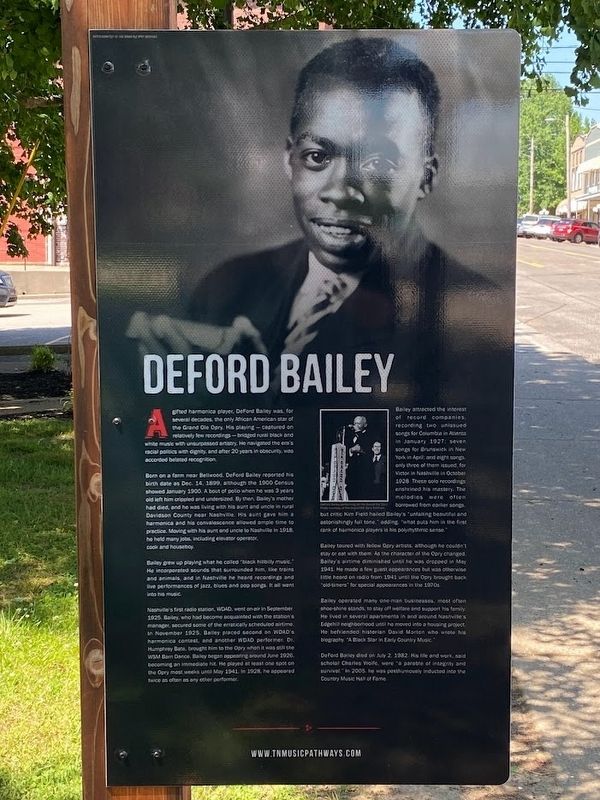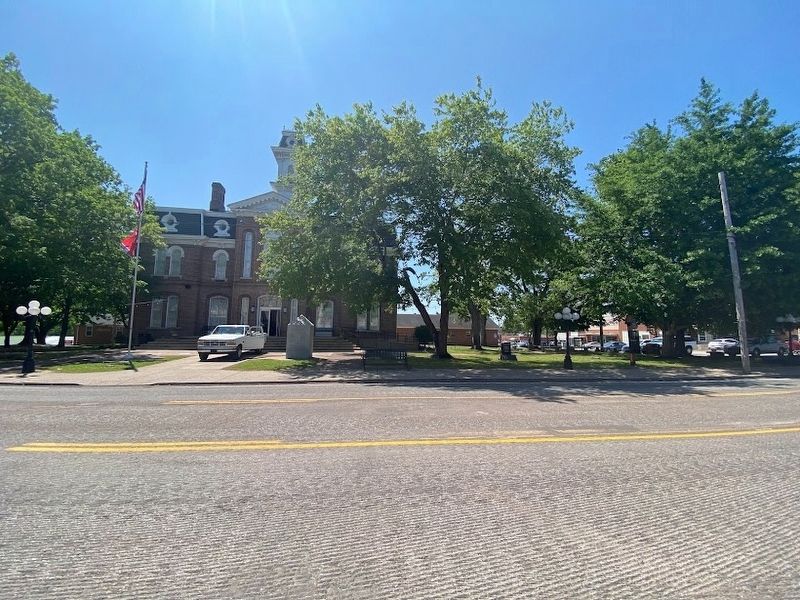Carthage in Smith County, Tennessee — The American South (East South Central)
DeFord Bailey
Born on a farm near Bellwood, DeFord Bailey reported his birth date as Dec. 14, 1899, although the 1900 Census showed January 1900. A bout of polio when he was 3 years old left him crippled and undersized. By then, Bailey's mother had died, and he was living with his aunt and uncle in rural Davidson County near Nashville. His aunt gave him a harmonica and his convalescence allowed ample time to practice. Moving with his aunt and uncle to Nashville in 1918, he held many jobs, including elevator operator, cook and houseboy.
Bailey grew up playing what he called "black hillbilly music." He incorporated sounds that surrounded him, like trains and animals, and in Nashville he heard recordings and live performances of jazz, blues and pop songs. It all went into his music.
Nashville's first radio station, WDAD, went on-air in September 1925. Bailey, who had become acquainted with the station's manager, secured some of the erratically scheduled airtime. In November 1925, Bailey placed second on WDAD'S harmonica contest, and another WDAD performer, Dr. Humphrey Bate, brought him to the Opry when it was still the WSM Barn Dance. Bailey began appearing around June 1926, becoming an immediate hit. He played at least one spot on the Opry most weeks until May 1941. In 1928, he appeared twice as often as any other performer.
Bailey attracted the interest of record companies, recording two unissued songs for Columbia in Atlanta in January 1927; seven songs for Brunswick in New York in April, and eight songs, only three of them issued, for Victor in Nashville in October 1928. These solo recordings enshrined his mastery. The melodies were often borrowed from earlier songs, but critic Kim Field hailed Bailey's "unfailing beautiful and astonishingly full tone," adding, "what puts him in the first rank of harmonica players is his polyrhythmic sense."
Bailey toured with fellow Opry artists, although he couldn't stay or eat with them. As the character of the Opry changed, Bailey's airtime diminished until he was dropped in May 1941. He made a few guest appearances but was otherwise little heard on radio from 1941 until the Opry brought back "old-timers" for special appearances in the 1970s.
Bailey operated many one-man businesses, most often shoe-shine stands, to stay off welfare and support his family. He lived in several apartments
in and around Nashville's Edgehill neighborhood until he moved into a housing project. He befriended historian David Morton who wrote his biography. "A Black Star in Early Country Music."
DeFord Bailey died on July 2, 1982. His life and work, said scholar Charles Wolfe, were "a parable of integrity and survival." In 2005, he was posthumously inducted into the Country Music Hall of Fame.
Erected by TN Music Pathways.
Topics. This historical marker is listed in these topic lists: African Americans • Entertainment.
Location. 36° 15.108′ N, 85° 57.129′ W. Marker is in Carthage, Tennessee, in Smith County. Marker is at the intersection of Main Street North and 3rd Avenue, on the right when traveling south on Main Street North. Touch for map. Marker is at or near this postal address: 220 Main St N, Carthage TN 37030, United States of America. Touch for directions.
Other nearby markers. At least 8 other markers are within walking distance of this marker. Smith County Veterans Memorial (a few steps from this marker); Benton McMillin (within shouting distance of this marker); Captain William Walton (within shouting distance of this marker); Smith County Courthouse Square (within shouting distance of this marker); Bragg Invades Kentucky (within shouting distance of this marker); Confederacy Memorial (within shouting distance of this marker); Edward Stallings (about 500 feet away, measured in a direct line); The Carthage Christian Church (about 500 feet away). Touch for a list and map of all markers in Carthage.
Credits. This page was last revised on June 2, 2023. It was originally submitted on May 31, 2023, by Darren Jefferson Clay of Duluth, Georgia. This page has been viewed 63 times since then and 30 times this year. Photos: 1, 2. submitted on May 31, 2023, by Darren Jefferson Clay of Duluth, Georgia. • James Hulse was the editor who published this page.

